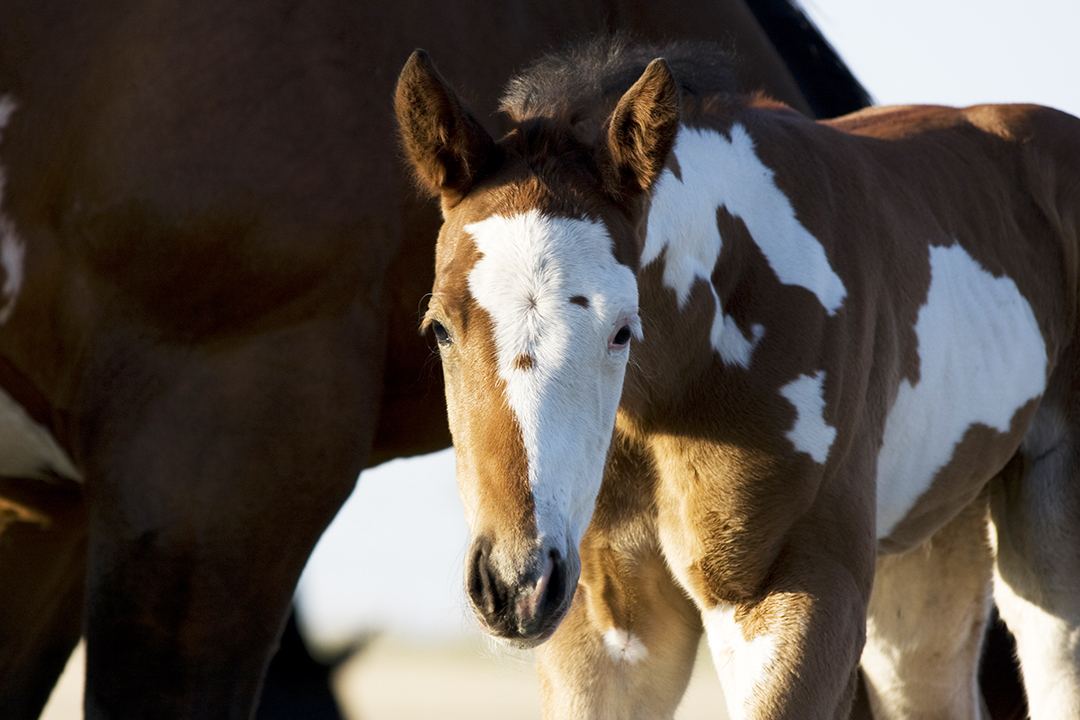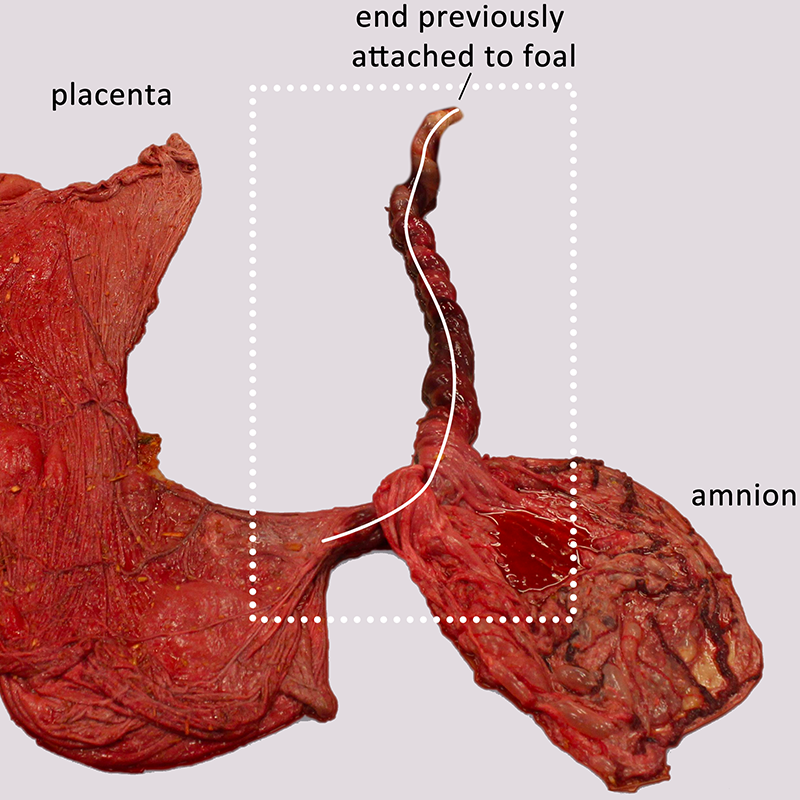
Unravelling the umbilical cord
Western College of Veterinary Medicine (WCVM) researchers have added a couple of new twists to research focusing on the link between equine umbilical cords and foal health.
By Myrna MacDonaldDr. Madison Ricard, a veterinary anatomic pathology resident in the WCVM's Department of Pathology, and her supervisor, Dr. Bruce Wobeser, are investigating whether excessively long umbilical cords or cords with more twists than usual affect the health outcomes of foals.
Previous studies have investigated the link between umbilical cord length and equine abortions, but this study is the first of its kind: “As far as we can tell, nobody has looked at that situation before on live foals. It’s always been on aborted foals,” says Wobeser.
The researchers are also relying on social media to find participants and online surveys and cell phone images to gather information — a cost-effective approach to data collection. Ricard, who develops websites and has an interest in social media, has been sharing the study’s details through horse breeding groups online.
“It is outside the norm,” says Wobeser. “But really, social media data collection is just survey data. We’re surveying a different group of people with different tools. It’s absolutely worth trying.”
The WCVM researchers are encouraging owners to enrol their pregnant mares in the study, which includes a few steps outlined on their website (wcvm-equs.ca). Immediately after foaling, the owner takes a photo of the umbilical cord and measures its length. Next, the owner records information about the mare, the foaling process, and the foal’s health at birth. These details can be submitted online or by using a printable, stall-side form.
“A lot of horse breeders out there already do these types of assessments of the [foal’s] placenta and umbilical cord … and they’re already measuring things like how long does it take for the foal to stand up and how long does it take for them to drink for the first time,” says Ricard.
The owner also fills out surveys about the foal’s health — one at seven days and another at 30 days after birth.
“If there’s anything unusual about the foal’s health, that’s what we want to capture,” says Ricard, who plans to sort information into categories such as infectious versus non-infectious conditions and congenital issues versus bacterial or viral infections.
“From there, we can do our statistics, home in on those categories, and then see the outcomes we find.”
Normally, equine umbilical cords measure 50 to 60 centimetres (20 to 24 inches) long and have four or five twists along its length. But excessively long or twisted cords can restrict blood supply to the fetus and cause significant health issues — often leading to death.
“In the U.K., for example, they have a really high incidence of umbilical cord torsions causing abortions. Whereas in other countries, they’re seeing a lot more infectious disease-causing abortions,” says Ricard.
Ricard and Wobeser conducted their own investigation to identify causes of equine abortions among Canadian horses. They found that, like the U.K., Canada has a higher rate of non-infectious fetal placental causes — including excessively long umbilical cords or torsions.
“Presumably, for every horse out there that has an umbilical cord torsion or excessively long umbilical cord, not all are going to abort. Some of them are going to be born, and that got me wondering: what is the outcome for those foals?” says Ricard.

Human medical researchers have found that too much twisting or excessively long umbilical cords can affect babies’ Apgar scores — the scoring system used to assess newborns’ well-being. Scientists have found links between these abnormal umbilical cords and issues such as still births, pulmonary hypertension and neurologic function deficits in babies.
“Although it’s human medicine, it suggests that there’s the potential for something to be there when it comes to umbilical cord morphology (form and structure) in these foals,” says Ricard.
With the foaling data, Ricard hopes to identify common patterns in the cords’ traits — similar to a pattern system established in human medicine. For each submission, she will also calculate an “umbilical cord index” — the number of twists in the cord divided by the cord’s length. Ricard will then compare those index numbers to reference values set in previous studies.
“Once it’s all done, we’re going to take all of this information that we’ve gathered about umbilical cords and see if we can find any connections between the umbilical cord data and the foals’ health data,” says Ricard.
But first, the WCVM researchers need data from many foalings over the next two years. They hope to capture data from breeding seasons in both northern and southern hemispheres.
“If we could get [access to] 500 foals, that would be amazing,” says Ricard.
A larger sample size also helps the researchers understand “what is in the realm of normal,” points out Wobeser. “It’s hard to say that horse with an umbilical cord of this length is a problem — you need a bigger data group representing horses of all sizes, origins and all those sorts of things [first].”
A large sample size will also allow them to learn more about issues with low incidence rates, adds Ricard. For example, a disease called neonatal hypoxic-ischemic encephalopathy may possibly be linked to abnormally long or twisted umbilical cords.
“But only one per cent of foals will be born showing signs of this neurologic condition. So, if we’re going to try and make these links between negative outcomes and umbilical cord characteristics, we need to have a lot of data.”
Based on this study’s findings, Ricard and Wobeser eventually plan to ask veterinary clinics for help in collecting placenta and umbilical cord tissue samples. These samples will allow them to do further histological studies targeting certain conditions. Collecting and analyzing tissue samples will cost money, but Wobeser says the good news is that this study is costing “essentially nil” — thanks to horse owners’ willingness to share information and Ricard’s online skills.
Public response has been very positive so far, and Ricard says many Facebook users have shared her original post, which will hopefully translate to increased participation.
“It would be interesting to look back at the study and determine how well the data collection process went and whether this approach could be potentially used for other studies targeting production animal species,” says Ricard. “It could be a new thing for veterinary medicine.”
Do you have a mare that’s scheduled to foal this year? Visit wcvm-equs.ca for more details about this study or contact Dr. Madison Ricard (madison.ricard@usask.ca).
